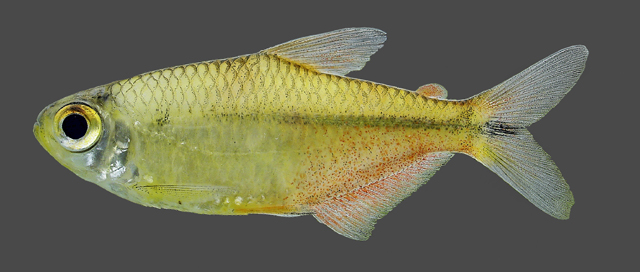| Characidae (Characins; tetras), subfamily: Stethaprioninae |
| 4.28 cm SL (male/unsexed) |
|
benthopelagic; freshwater |
| South America: rio Salgado and rio Almada in Brazil. |
|
Dorsal soft rays (total): 10-11; Anal soft rays: 23-26; Vertebrae: 33-33. Diagnosed from all its congeners from northeastern Brazilian drainages by having distal portion of pelvic fins dark, a combination of sexually dimorphic characters, posteroventral portion of body and fins (except pectoral) reddish in life, and inconspicuous humeral and caudal spots. Can be further distinguished by having the following characters: highest body depth just anterior of dorsal-fin origin, scales on lateral line 32-34; five series of scales between dorsal origin and lateral line; three series of scales between lateral line and pelvic-fin origin; anal fin with 20-23 branched rays; dorsal usually ii,8,i; base of anterior anal-fin rays with 8-12 scales; one or two maxillary teeth; presence of no more than 5 cusps and dentary teeth abruptly decreasing in size posteriorly (Ref. 81202).
Description: Dorsal-fin rays ii,8, ii,8,i, or ii,9; anal-fin rays iii,20, 21, 22, or 23; pectoral-fin rays i,9, 10, 11, or 12; pelvic-fin rays i,6 or 7. Scales rows between lateral line and pelvic-fin insertion 3 (Ref. 81202). |
| Inhabits clear water streams, running over rocky, pebbles and sand bottom at low altitudes ranging from 188 to 258 m, with slow to moderate water current and less than 1 m deep (Ref. 81202). Stomach contents of three specimens include filamentous algae, fragments of vascular plants and seeds, insects and other unidentified arthropods, and organic debris (Ref. 81202). |
|
Least Concern (LC); Date assessed: 07 November 2018 Ref. (130435)
|
| harmless |
Source and more info: www.fishbase.org. For personal, classroom, and other internal use only. Not for publication.

